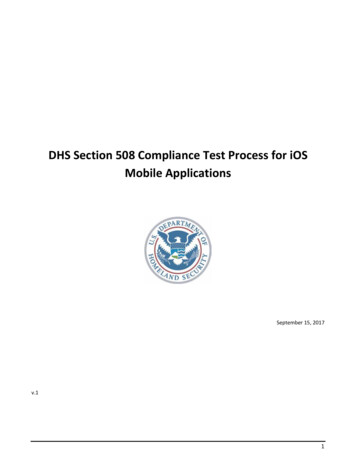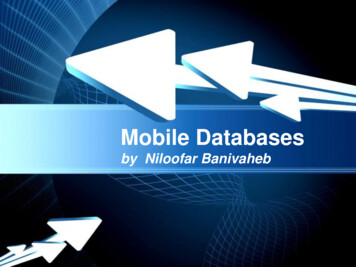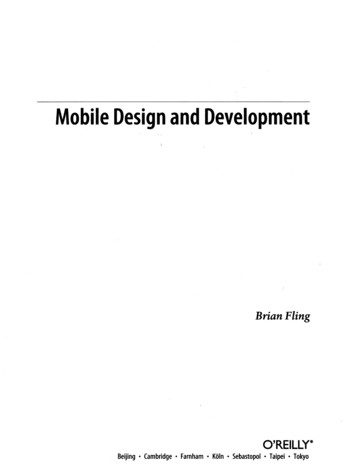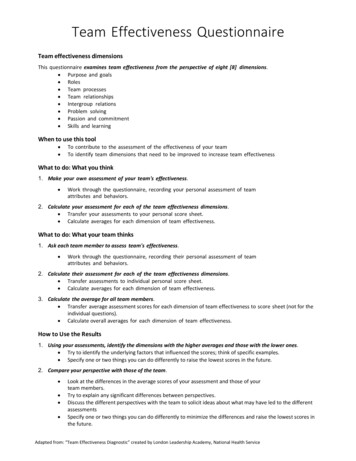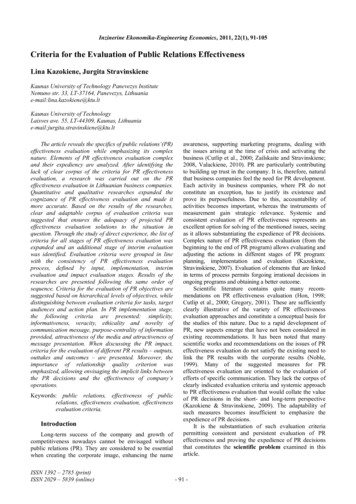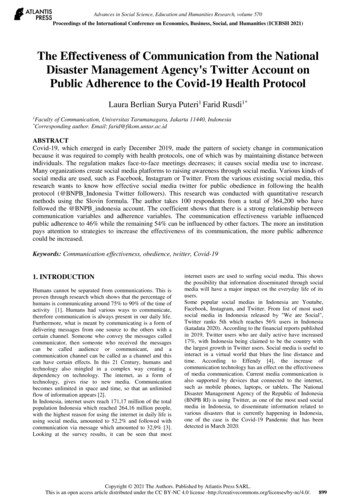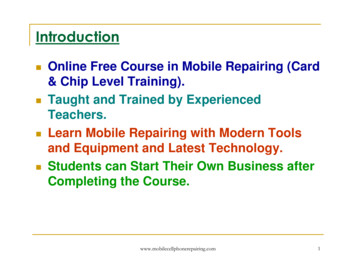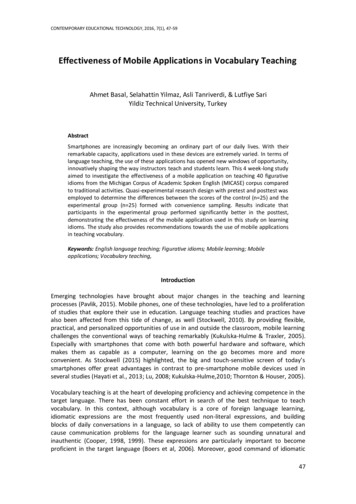
Transcription
CONTEMPORARY EDUCATIONAL TECHNOLOGY, 2016, 7(1), 47-59Effectiveness of Mobile Applications in Vocabulary TeachingAhmet Basal, Selahattin Yilmaz, Asli Tanriverdi, & Lutfiye SariYildiz Technical University, TurkeyAbstractSmartphones are increasingly becoming an ordinary part of our daily lives. With theirremarkable capacity, applications used in these devices are extremely varied. In terms oflanguage teaching, the use of these applications has opened new windows of opportunity,innovatively shaping the way instructors teach and students learn. This 4 week-long studyaimed to investigate the effectiveness of a mobile application on teaching 40 figurativeidioms from the Michigan Corpus of Academic Spoken English (MICASE) corpus comparedto traditional activities. Quasi-experimental research design with pretest and posttest wasemployed to determine the differences between the scores of the control (n 25) and theexperimental group (n 25) formed with convenience sampling. Results indicate thatparticipants in the experimental group performed significantly better in the posttest,demonstrating the effectiveness of the mobile application used in this study on learningidioms. The study also provides recommendations towards the use of mobile applicationsin teaching vocabulary.Keywords: English language teaching; Figurative idioms; Mobile learning; Mobileapplications; Vocabulary teaching,IntroductionEmerging technologies have brought about major changes in the teaching and learningprocesses (Pavlik, 2015). Mobile phones, one of these technologies, have led to a proliferationof studies that explore their use in education. Language teaching studies and practices havealso been affected from this tide of change, as well (Stockwell, 2010). By providing flexible,practical, and personalized opportunities of use in and outside the classroom, mobile learningchallenges the conventional ways of teaching remarkably (Kukulska-Hulme & Traxler, 2005).Especially with smartphones that come with both powerful hardware and software, whichmakes them as capable as a computer, learning on the go becomes more and moreconvenient. As Stockwell (2015) highlighted, the big and touch-sensitive screen of today’ssmartphones offer great advantages in contrast to pre-smartphone mobile devices used inseveral studies (Hayati et al., 2013; Lu, 2008; Kukulska-Hulme,2010; Thornton & Houser, 2005).Vocabulary teaching is at the heart of developing proficiency and achieving competence in thetarget language. There has been constant effort in search of the best technique to teachvocabulary. In this context, although vocabulary is a core of foreign language learning,idiomatic expressions are the most frequently used non-literal expressions, and buildingblocks of daily conversations in a language, so lack of ability to use them competently cancause communication problems for the language learner such as sounding unnatural andinauthentic (Cooper, 1998, 1999). These expressions are particularly important to becomeproficient in the target language (Boers et al, 2006). Moreover, good command of idiomatic47
CONTEMPORARY EDUCATIONAL TECHNOLOGY, 2016, 7(1), 47-59expressions is generally considered as becoming closer to the fluency of native speakers of thetarget language (Fernando, 1996; Schmitt, 2000; Wray, 2000). Therefore, as Irujo (1986)emphasized, teaching idioms should be an integral part of language teaching programs frombeginning levels and taught in naturalistic contexts with ample chances of practice. However,while teaching idioms, difficulties arise (Zhang, 2009).Mobile devices could open new doors with their unique qualities such as “accessibility,personalizability, and portability” (Saran & Seferoglu, 2010, p.253), and “the physicalcharacteristics (e.g., size and weight), input capabilities (e.g., keypad or touchpad), outputcapabilities (e.g., screen size and audio functions), file storage and retrieval, processor speed,and the *low error rates” (Alzu’bi & Sabha, 2013, p.179) in the teaching and learningprocesses.Literature ReviewThe past decade has seen the rapid development in using mobiles phones in vocabularyteaching and the focus has been on the role of these devices in teaching vocabulary to L2learners. A feature of mobile phones that was initially widely used in the studies was the SMS(Short Message Service). Several experimental studies compared SMS-based vocabularyinstruction to different types of more traditional instruction. For example, Lu (2008) and Zhanget al. (2011) both attempted to investigate the effect of SMS messages compared to printedmaterials. Results of their studies showed that SMS groups outperformed the control groupswho were given printed materials in the posttest; however, there was no significant differencein the delayed posttests.Similarly, Suwantarathip and Orawiwatnakul (2015) conducted an experimental study thatcompared the effect of in-class paper-based vocabulary exercises with SMS messages sent tostudents outside the classroom to teach and practice new vocabulary for a 6-week long period.The study reported that the participants in the experimental group outperformed the controlgroup.In addition to the text messaging capabilities of SMS, Saran and Seferoglu (2010) also usedMMS (Multimedia Messaging Service) in their study. While the experimental group was taughtvocabulary via SMS and MMS messages that included multimedia such as images and sounds,the control group was taught the same vocabulary items in the classroom. The scores of theexperimental group were significantly higher than the control group in the post test.In their study, to compare the effects of SMS versus paperback dictionaries in academicvocabulary learning, Alemi et al. (2012) found that there was no significant difference betweenvocabulary knowledge of two groups in the post tests; however, the SMS group was moresuccessful in the delayed posttest. Furthermore, all these studies reported positive attitudes ofstudents towards the use of SMS in vocabulary learning.Platforms and programs other than messaging services were also used in teaching vocabularyon mobile devices. Thornton and Houser (2005) wanted to test the effectiveness of e-mails onmobile phones on vocabulary teaching. In the first 4 week-long experiment, they sent studentsmini vocabulary lessons via emails, which students received on mobile phones for the first 2weeks, and via computers for the last 2 weeks. In the second experiment, students weredivided into 2 groups, one of which received emails while the other had the same content as48
CONTEMPORARY EDUCATIONAL TECHNOLOGY, 2016, 7(1), 47-59printed material. Students reported that using mobile phones was a more effective methodand more preferable to computers and printed materials. The last experiment was theevaluation of a website that the authors, together with their students, developed to teachidioms. Vidioms included idioms with explanations, and examples through multimedia (sounds,images, videos). The authors asked a group of students to evaluate the website as they used iton mobile devices such as phones and PDAs. Students found the website significantly ‘effectiveand enjoyable’ (p. 225) to use on mobile devices.Basoglu and Akdemir (2010) conducted a study on vocabulary learning to see the difference ofuse of mobile phones and flashcards. They used a mobile application for experimental groupgiving the words for six weeks while the control group learned the same words with flashcards.Their study reported a significant difference between two groups as the experimental groupdid achieve significantly better in the multiple-choice posttest.Another example is Stockwell (2010) who compared vocabulary learning on mobile phonesand computers in relation to student achievement, task completion speed, and time for a 3year period between 2007 and 2009. A Moodle-based system called VocabTutor wasdeveloped to run both on computers and mobile devices. Findings of the study showed nosignificant difference in terms of student scores; however, most students preferred using thesystem on computers with an increase of mobile phone use in 2009.As a recent study that made use of smartphones, Wu (2015) created a mobile applicationcalled Word Learning-CET6 to teach vocabulary to a group of 70 Chinese college students.While the experimental group used the application, the control group was only reminded tostudy the vocabulary items on their own via text messages. The posttest results at the end ofthe experiment reported a significant different between two groups with experimental groupoutperforming the control group.As can be seen in the above mentioned studies, experiments with different types of mobilelearning tools varying from SMSs to applications that were written to teach vocabulary have allbeen proved to have benefits for the learners compared to more conventional ways oflearning.To the best knowledge of the researchers, few studies on idiom teaching through mobiledevices were found in the literature. One of them is an experiment in Thornton and Houser(2005) which was the evaluation of a website that the authors, together with their students,developed to teach idioms. Vidioms included idioms with explanations, and examples throughmultimedia (sounds, images, and videos). The authors asked a group of students to evaluatethe website as they used it on mobile devices such as phones and PDAs. Students found thewebsite significantly ‘effective and enjoyable’ (p. 225) to use on mobile devices. Another studyis by Hayati et al. (2013) who investigated the teaching of idioms to a group of 80 IranianEnglish learners. Students were divided into 3 groups, each of which received a different typeof instruction to learn 80 idioms. The first group was the self-study group that received theidioms with their definitions and examples through printed material. The second groupreceived 4 SMS messages that covered 4 idioms along with meanings and example sentences,while the last group was taught through short texts rather than definitions for a morecontextualized instruction, and in the classroom. The post-test results showed that scores in allgroups were significantly different, with SMS group being the highest, and the self-study groupthe lowest. Furthermore, responses to the post-experiment survey indicated that studentsmostly found use of mobile phones and SMS messages effective and preferable as a teaching49
CONTEMPORARY EDUCATIONAL TECHNOLOGY, 2016, 7(1), 47-59method. As can be seen, both studies attempted to use mobile devices , however, neither ofthem was able to fully utilize what smartphones offers today with various free and easy-to-useapplications that learners can easily reach.Although many studies found SMS messages and other computer software adapted to mobilephone effective in vocabulary learning, affordances of these tools are limited. For example,SMS messages can be costly for students (Cavus & İbrahim, 2009) or computer programsrequire adjusting for mobile devices, which can cause problems in quality of use (Thornton &Houser, 2005). Therefore, using the smartphone applications that are already well-functioningand popular among users could facilitate the mobile learning practices considerably.Moreover, applications of mobile learning are advantageous in language teaching (GodwinJones, 2011).Wang and Shih (2015), for instance, used mobile vocabulary learning application in their studyand concluded that experimental group scored significantly better than the control group whoused paper-based learning materials. A good example of mobile applications is WhatsApp, afree mobile messenger application that allows its users to exchange texts, as well asmultimedia both in one-to-one and group conversations, and make calls. Being one of themost popular and widely used messenger applications, it is also available for all mobileplatforms (IOS, Android, Windows Mobile, Symbian, etc.).As an effective means of mobile communication, WhatsApp has been used in some studiesthat aimed to investigate its effectiveness in terms of language learning. Plana et al. (2013)aimed to provide EAP students with extra reading activities by sending links to short texts andrelated comprehension questions through WhatsApp groups, as an alternative to SMS which ismore costly, and less convenient without a computer system to send messages. Thequestionnaires after the twelve week-long implementation showed that students liked theactivities, and increased their reading practice with the application.Al Saleem (2014) aimed to examine the effect of dialogue journaling via WhatsApp onundergraduate English students’ writing performance in terms of vocabulary and voice. Duringthe six weeks of data collection, students were given 30 prompts to write on and viaWhatsApp. The two writing tasks given as pre-test and post-test indicated that there was asignificant improvement in students’ writing in terms of their word choices and voice.Lawrence (2014) also used WhatsApp groups in order to introduce vocabulary items beforereading texts to a group of five undergraduate learners of Afrikaans. For a 7 week-long period,the researchers sent messages to the group that introduced target words with translations anddifferent types of media such as sound or image. Content of the messages were furtherelaborated in each following course and students’ knowledge was tested. The authorconcluded that WhatsApp is an effective tool for providing outside-the-classroomopportunities to practice vocabulary especially for weak students; however, content of themessages should be carefully planned.Castrillo et al. (2014) investigated the role of WhatsApp in fostering negotiation of meaningamong 85 Spanish learners of German. Based on the results of the pre-questionnaire, studentswere divided into 5 WhatsApp groups of five, where they discussed topics that the authorsent. Students’ interactions in terms of their negotiation of meaning and engagement with thetasks were analyzed. Students were found to have high levels of motivation and participation,as well as having improved their meaning negotiation skills. Although some research has been50
CONTEMPORARY EDUCATIONAL TECHNOLOGY, 2016, 7(1), 47-59carried out on the use WhatsApp in vocabulary teaching and, there have been few empiricalinvestigations into its use in idiom teaching. The present study therefore is set out to assessthe effectiveness of the mobile application in teaching idioms.MethodologyResearch DesignThis study aims to investigate the effectiveness of the mobile application on teaching 40figurative idioms from the Michigan Corpus of Academic Spoken English (MICASE) compared totraditional activities. Posttest-only two-group randomized experimental design model wasemployed in the study. The research question that guided the study was: Are activities withthe use of mobile applications more effective than traditional activities in increasing idiomaticknowledge of the participants?ParticipantsThe number of participants who took part in the study was 50 first-year students from anEnglish Language Teaching Department of a state university in Turkey. Convenience samplingwas employed while selecting the participants. Their level could be defined as upperintermediate since they are accepted to the department with Foreign Language Exam (YDS)scores. The participants were enrolled in the course called Lexical Competence in the springsemester of the academic year 2013-2014, a compulsory course aiming to expand thevocabulary knowledge of the students. The participants were divided into two groupsrandomly; control group consisted of 6 males and 19 females (n 25) and experimental group(n 25) consisted of 20 females and 5 and had an average of 20 in terms of their age. Thecontrol group was taught with traditional activities whereas the experimental group wastaught with the use of mobile application.Data AnalysisThe idioms in this study were from Michigan Corpus of Academic Spoken English (MICASE). Thecorpus included contemporary speech recordings of 152 academic lectures over 197 hoursfrom the University of Michigan between 1997 and 2001 (Simpson & Mendis, 2003). Fortyfigurative idioms (e.g. ivory tower, bottom line, go off on a tangent, on the same page, litmustest, play devil’s advocate, ring a bell, split hairs etc.) listed by Grant (2007) based on the studyof Simpson and Mendis (2003) were used in the study.The achievement test consisting of 40 questions on figurative idioms was used as the datacollection tool. Internal validity of the questions in the test was established by using a panel ofexperts from the field of English language teaching. Each question answered correctly in thetest was given 1 point. The test was used both as the pretest and posttest. The t-test was usedto determine whether the differences between inter and intra groups were statisticallysignificant. The achievement test included 40 fill-in-the blanks questions testing the knowledgeof participants on figurative idioms. Sample items from the test are as follows:51
CONTEMPORARY EDUCATIONAL TECHNOLOGY, 2016, 7(1), 47-59Please fill the blanks with the appropriate idioms from the list below. If necessary, please makechanges.the big picture /go off at a tangent / ivory tower / litmus test / put the heat on1. Environmental groups are putting the heat on the government to stop pollution frompower stations.2. What does the professor know about student life, living as he does in an ivory tower?3. The president's policy on abortion is regarded as a litmus test of his views on women'srights.4. The ideal candidate for the job should be able to look at the big picture and prioritizework. Our discussion on fund-raising went off at a tangent, and we spent half themorning talking about political correctness.ProceduresAt the start of the study, the participants of the two groups were tested on their knowledge ofthe selected 40 figurative idioms. Based on this pretest results, there were no significantdifference between the two groups, indicating that their knowledge level was similar on theselected idioms. The following week, the study and its focus on idioms were introduced toboth groups. However, it is also important to consider the technology usage of the learners,and create the learning environments accordingly (Liu & Milrad, 2010). As an indication of howquickly Turkish users have adopted mobile devices in recent years, Connected CustomerSurvey by Google (2014) indicated that smartphone usage reached 39% and had tripled since2012. Considering all these, teaching idioms through smartphones may be an effective way ofintegrating teaching into real life contexts.In this context, the participants of the experimental group were asked whether they haveWhatsApp mobile application on their mobile phones and how frequently they use them. All ofthe participants had this application on their mobile phones and stated that they used itfrequently. After this check, the control group was given printed handouts including traditionalactivities on the idioms such the meaning of idioms, usage examples and fill in the blanksexercises. The experimental group on the other hand was taken MMS messages through theuse of WhatsApp mobile application on a weekly basis.Every week, 10 MMS messages related with the target idioms (see appendix for the examplesof MMS messages) were sent to the experimental group. The MMS contains the idiom,meaning of the idiom, a picture demonstrating the meaning of the idiom, and at least 3 samplesentences for each idiom. After sending MMS messages of 10 idioms, a mini test including fillin the blanks questions were sent to the participants as an MMS and the answers to the minitest was sent after 2 hours. This process took four weeks to complete. After the treatmentcompleted, the achievement test was used as the posttest.ResultsThe pretest results of the control group who learned idioms with traditional paper-basedactivities in the classroom can be seen in Table 1. Findings revealed that the participants in the52
CONTEMPORARY EDUCATIONAL TECHNOLOGY, 2016, 7(1), 47-59control group achieved significant improvement (p 000.5) on their idiom knowledge when theresults of pretest (M 15,24) and immediate posttest (M 23,00) were compared. This meansthat after four weeks following the start of the study, participants in the control groupexperienced significant idiom-knowledge gains, suggesting that traditional activities wereeffective in teaching target idioms in the study.Table 1. Paired Samples t-test Results Within Groupt-testC. G. PretestC. G. Posttest ,001The results of the pretest of the experimental group who learned idioms with the mobileapplication out of the classroom hours can be seen in Table 2. Findings revealed that theparticipants in the experimental group achieved significant improvement (p 000.5) on theiridiom knowledge when the results of pretest (M 17,48) and posttest (M 31,55) werecompared. This means that after four weeks following the end of the treatment, participants inthe experimental group also experienced significant idiom-knowledge gains, indicating that theuse of mobile application was effective in teaching the target idioms in the study.Table 2. Paired Samples t-test Results Within Groupt-testE. G. PretestE. G. Posttest ,001The study aims to determine whether the use of mobile application was more effective thanthe traditional activities in teaching the target idioms. It is clear from Table 3 that both groupshad significant idiom-knowledge gains after the 4-weeks-long study, demonstrating that thestudents in both groups improved their idiom-knowledge significantly independent of thegroup they were in and the activities they were supposed to do. However, as seen in the table,the experimental group achieved significantly better results on the posttest than the controlgroup. In other words, when compared to the control group, idiom-knowledge gains of theexperimental group were significantly higher than those of the control group, suggesting thatthe treatment was successful in teaching idioms.Table 3. Independent Samples t-test Results Between Groupst-testC. G. PretestE. G. PretestC. G. Posttest 1E. G. Posttest 1N25292529̅15,240017, 1,045df52p,284-5,21052,00153
CONTEMPORARY EDUCATIONAL TECHNOLOGY, 2016, 7(1), 47-59Discussion and ConclusionVocabulary learning is one of the most important aspects of language teaching. Idioms, anessential part of vocabulary knowledge, and idiomatic knowledge can help learners to becomeproficient in the target language (Boers et al., 2006). However, learning idioms is a majordifficulty for many language learners in achieving a more natural sounding target languagecompetence (Cooper, 1998, 1999). When it comes to teaching idioms, it becomes moredifficult since it is hard to predict their meaning with the first look (Zhang, 2009). Therefore,there is a door of opportunities for creating appropriate environments to teach idioms,particularly with the use of broadly available technologies, one of which is through mobileapplications.Many studies proved that SMS messages and other computer programs adjusted to be used inmobile phones can be effective for vocabulary teaching. However, there may be somedisadvantages of using SMS due to its cost (Cavus & Ibrahim, 2009) and other computerprograms due to the adjustment problems of these programs to mobile devices, causing lowquality (Thornton & Houser, 2005). Therefore, using the smartphone applications that arealready well-functioning and popular among users could facilitate the mobile learning practicesconsiderably. A good example of these applications is WhatsApp, a free mobile messengerapplication that allows its users to exchange texts, as well as multimedia both in one-to-oneand group conversations, and make calls. Being one of the most popular and widely usedmessenger applications, it is also available for all mobile platforms (IOS, Android, WindowsMobile, Symbian etc.). This study aims to investigate the use the effectiveness of this mobileapplication on teaching 40 figurative idioms from the MICASE corpus compared to traditionalactivities.Results of this study indicate that both the participants in the control and the experimentalgroup significantly improved their knowledge of the target idioms independent of the activitytype used in their respective groups. However, based on the posttest results, participants inthe experimental group who learned idioms through the use of the mobile applicationachieved significantly better than their counterparts in the control group with traditionalactivities, indicating that use of the mobile application was more effective in teaching idiomsthan the traditional activities.These results are in line with the results of several other studies employed SMS or MMS in theexperimental group and traditional activities in the control group in vocabulary teaching (Lu,2008; Saran & Seferoglu, 2010; Zhang, 2011); however, they are contradictory with thefindings of Alemi et al. (2012). On the other hand, even though Alemi did not find significantdifferences between the experimental and control groups on the posttest, the researcherfound significant differences in the delayed posttest, indicating that using mobile applicationssignificantly improved the retention of the vocabulary when compared to traditional activities.Moreover, the studies reported positive attitudes of students towards the use of mobileapplications in teaching vocabulary.In a study conducted by Hayati et al (2013) to teach idioms with three different ways (selfstudy, SMS, and more contextualized instruction in class), the results indicated that SMS groupimproved significantly better than the other two groups with positive feedback on usingmobile phones and SMS in learning idioms. Basoglu and Akdemir (2010) also found thatteaching vocabulary with mobile phones is more effective than presenting the vocabulary inflashcards. Lu (2008) also found that the participants of the SMS group recognized more54
CONTEMPORARY EDUCATIONAL TECHNOLOGY, 2016, 7(1), 47-59vocabulary than the group learned vocabulary with printed materials. Suwantarathip andOrawiwatnakul (2015) also found that the experimental group in which mobile-assistedvocabulary exercises were used outperformed the control group receiving paper-basedexercises. All the results of aforementioned four studies seem to be consistent with the resultsof the current research which found that using mobile applications is more effective inteaching vocabulary compared to the traditional ways of teaching.Learning vocabulary in the classroom may be disadvantageous due to time constraints and theheavy responsibility on the learner (Grace, 1998). The advantage of using mobile phones andmobile applications in teaching vocabulary is having an opportunity to learn beyond classroomborders. In other words, “instructional activities are not limited to a set place but can beconducted anywhere and anytime [and] learners can engage, often asynchronously, withteachers, learning resources and other learners” (Bornman, 2012, p.288).However, as Kukulska-Hulme (2009) stated this can also be disadvantageous since the learningoutside the classroom is beyond the control of the teacher, thus careful planning should bemade to establish a strong connection between “what is best learnt in the classroom, *and what should be learnt outside [the classroom ” (p.164). Therefore, teachers should have theresponsibility of designing activities to achieve optimum balance between the content in- andoutside the classroom. While maintaining such a balance, they should “seek ways to constructthe content more enjoyable for their students” (Basal, 2012, p.167). In this process, with theuse of mobile phones, learning activities may become more engaging (Cui & Bull, 2005).The current study contributed to the literature in that using mobile applications in vocabularyteaching can be a more effective tool when compared to traditional paper-based activities.However, designing language learning activities, in this case vocabulary learning activities, is ademanding task and requires careful planning. Moreover, while using mobile applicationswhich are not tailored for vocabulary teaching, language teachers should be aware ofpedagogical considerations in the design of the vocabulary activities. Language teachers shouldalso pay special attention to the use of ready-made mobile applications for vocabularyteaching since the number of them are countless and although they were originally tailored forvocabulary teaching and the developers of them claim that they were carefully designed in linewith the scientific findings related to vocabulary teaching, to prove these claims can be adaunting task to their huge numbers. Therefore, teachers should know how to evaluate theusefulness of these applications for vocabulary teaching.This study has some limitations regarding the limited number of the participants. Large-scalestudies need to be done in order to understand its strengths and weaknesses in teachingspecific aspects of language. Moreover, more research needs to be undertaken in order toconfirm the strength of the association between mobile applications and their effectiveness inteaching vocabulary.ReferencesAlemi, M., Sarab, M. R. A., & Lari, Z. (2012). Successful learning of academic word list viaMALL: Mobile assisted language learning. International Education Studies, 5(6),99-109 .http://dx.doi.org/10.5539/ies.v5n6p9955
CONTEMPORARY EDUCATIONAL TECHNOLOGY, 2016, 7(1), 47-59Alsaleem, B. I. A. (2013). The effect of “WhatsApp” electronic dialogue journaling on improvingwriting vocabulary word choice and voice of EFL undergraduate Saudi students. ArabWorld English Journal, 4(3), 213-225.Alzu
Vocabulary teaching is at the heart of developing proficiency and achieving competence in the target language. There has been constant effort in search of the best technique to teach vocabulary. In this context, although vocabulary is a core of foreign language learning, idiomatic expressions


